| Australia at the 1992 Summer Paralympics | |
|---|---|
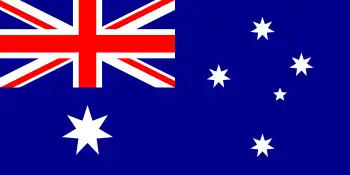 | |
| IPC code | AUS |
| NPC | Australian Paralympic Committee |
| Website | www |
| in Barcelona | |
| Competitors | 134 in 13 sports |
| Flag bearer | Terry Giddy (Opening) Priya Cooper (Closing) |
| Medals Ranked 5th |
|
| Summer Paralympics appearances (overview) | |
Australia competed at the 1992 Paralympic Games in Barcelona for physically and vision-impaired athletes. Immediately after the Barcelona Games, the city of Madrid held events for athletes with an intellectual disability. The Madrid results are not included in International Paralympic Committee Historical Results Database. Australia finished 7th in the total medal count winning 76 medals (24 gold, 27 silver and 25 bronze medals). Australia competed in 13 sports and won medals in 3 sports – swimming, athletics and weightlifting.[1] Australia finished first in the medal tally at the 1992 Paralympic Games for Persons with Mental Handicap in Madrid.

Notable Performances
Notable Australian performances included:
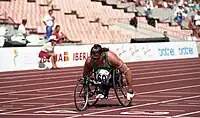
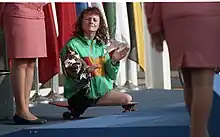
- Louise Sauvage, a wheelchair racer, winning 3 gold medals and 1 silver medal[2][3]
In her first Paralympics, Louise Sauvage, at only 19 became the first women to break the 30sec mark for the 200m with a time of 29.03 winning her third gold medal of the games. "You get such a buzz when you win, I love it", Sauvage said.[4]
- Priya Cooper, a cerebral palsy swimmer, winning 3 gold medals and 2 silver medals[2][3] She carried the Australian flag at the closing ceremony.
- Anne Currie, an S6 swimmer, winning 3 gold and 1 bronze medals[2][3]
- Four athletes won two gold medals – visually impaired thrower Russell Short, cerebral palsy sprinter Alison Quinn, visually impaired swimmer Tracey Cross and swimmer Tracy Barrell[2][3]
- Jodi Willis competed in athletics and goalball and won gold in the Women's Shot Put B2 and silver in the Women's Discus B2. She was the last Australian athlete to compete in more than one sport at the same Games.[2][3]
Previously many athletes competed in multiple sports at the same Games.
Team

Australia was represented by 134 athletes (93 men and 41 women).[5] The team was organised around disabilities – amputee, cerebral palsy, vision impaired and wheelchair. Each disability group had its own section manager and staff. This was the last time the Australian team was organised in this manner. The Chef de Mission was George Dunstan.[2]
Team headquarters staff:
Administration – George Dunstan (Chef de Mission), Derry Beavis (Team Manager), Judy Haines, Paul Griffiths, Adrienne Smith
Section Managers – Paul Bird (Amputee), Gary Prior (Vision impaired), Corny van Eldik (Cerebral palsy), Michael Godfrey-Roberts (Wheelchair)
Medical – John Burke (Team Medical Officer), Norma Beer, Jane Buckley, Nicola Meintjes, Don Perriman, Greg Ungerer, Lyn Wilcox
Escorts – Joanne Sayers, Craig Jarvis, Rob Stubbs[2]
Medalists
Events
Archery
Archery was first included in the 1960 Paralympic Games, and has been included in every games since, making it one of the oldest sporting events for disabled athletes. Archery is open to cerebral palsy, amputee and wheelchair athletes.[6]
Australia represented by:
Men – Arthur Fisk, Eric Klein[2][3]
Australia did not win any medals.[7]
Results
| Athlete | Event | Result | Rank |
|---|---|---|---|
| Eric Klein | Men's Individual AR2 | 1184 | 12 |
| Arthur Fisk | Men's Individual AR2 | 1168 | 17 |
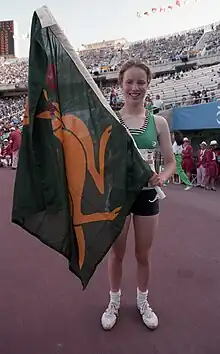
Athletics

Athletics, being one of the oldest Paralympic Sports, includes a number of different field events. These events are high jump, long jump, triple jump, shot-put, discus, javelin, club and the pentathlon. There are different classifications according to levels of impairment for athletes to compete in, and the letters are used to indicate the type of event, with 'T' meaning track event and 'F' meaning field event.[6]
Australia represented by:
Men – Robert Biancucci, Fabian Blattman, David Bonavita, Brendan Bowden, Allan Butler, Darren Collins, Paul Croft, Mark Davies, Phillip Deveraux, Alan Dufty, John Eden, David Evans, Karl Feifar, Neil Fuller, Terry Giddy, David Goodman, Michael Hackett, Tony Head, Edward Holicky, John Lindsay, Hamish MacDonald, Stuart Miller (guide for Darren Collins), Kerrod McGregor, Kieran Modra, Michael Nugent, Rodney Nugent, Sam Rickard, Jaime Romaguera, Eric Russell, Craig Sayers, Christopher Scott, Russell Short, Greg Smith, Bradley Thomas, Darren Thrupp, Vincenzo Vallelonga, Bruce Wallrodt, Mark Whiteman, Ross Whyte, Paul Wiggins, Jason Willis, Matthew van Eldik, Kyrra Grunnsund
Australia's first medal of the ninth Paralympic Games in Barcelona was won by Canberra-based John Eden who won a silver medal in discus setting a new Australian record with a throw of 39.94 metres.[8]
Women – Marsha Green, Yvette McLellan, Alison Quinn, Louise Sauvage, Donna Smith, Karen Smith, Jodi Willis
Coaches – Chris Nunn (amputee), Karen Denman (Cerebral palsy), Jo Hogan (cerebral palsy), Jenni Banks (Wheelchair)
Officials – David Reid (Blind Athletics Manager), Trevor Goddard (guide runner), Stuart Miller (guide runner), Rick Grant (personal attendant)[2][3]
Athletics was Australia's most successful sport delivering 40 medals – 13 gold, 15 silver and 12 bronze. 12 athletes came home with individual gold medals. Australia placed 6 in the overall medal tally for athletics.

"I have now been to three Paralympics and I belong to a very special group of athletes. Barcelona was the beginning of it all. I will never forget my first Paralympic gold medal and the feeling of having it around my neck with the anthem being played and the Australian flag raised up high because I was the best in the world. Barcelona gave me the taste and I wanted more."
Louise Sauvage[9]
| Athlete | Event | Result | Rank |
|---|---|---|---|
| Allan Butler, Karl Feifar, Neil Fuller, Rodney Nugent | Men's 4 × 100 m Relay TS2,4 | 45.95 WR | |
| John Lindsay | Men's 200m TW3 | 27.45 WR | |
| Russell Short | Men's Discuss B3 | 45.94m PR | |
| Russell Short | Men's Shot Put B3 | 13.81m PR | |
| Darren Thrupp | Men's Long Jump | 5.78 WR | |
| Bruce Wallrodt | Men's Javelin THW4 | 25.56 PR |
WR = World record
PR = Paralympic record
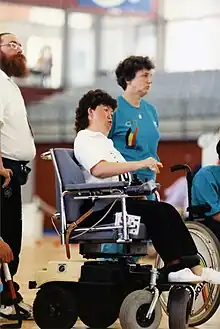
Boccia
Boccia was first included in the Paralympics in the 1992 Summer Paralympic Games. It started out originally as a team sport for athletes with cerebral palsy, and the disabled players use bowling ramps that have been specially designed to bowl Boccia balls as close as possible to the white jack.[6]
Australia represented by:
Men – Burke Gibbons, Corey Molan, Alexander Xeras
Women – Lyn Coleman
Officials – Tom Organ (Manager)[2][3]
Australia did not win any medals.
Cycling
Cycling was originally competed in by athletes with vision impairment, with the first events being in the early 1980s. However, in the 1992 Paralympics, events for vision-impaired, amputee and cerebral palsy athletes were combined for the first time. Sighted front riders compete with vision-impaired cyclists in tandem.[6]
Australia represented by:
Men – Ronald Anderson, Paul Clohessy, Craig Elliott, Timothy Harris (Pilot for Prue-Anne Reynalds), Paul Lamond (Pilot for Ron Anderson)), Stephen John Smith, Peter Stoltzer (Pilot for Paul Clohessy))
Women – Prue-Anne Reynalds
Officials – Ken Norris (Manager)[2][3]
Australia did not win any medals.
Goalball

Goalball is the only Paralympic team sport for vision-impaired athlete and has been art of the competition program since 1976. It is played by two teams of three players who are all blindfolded. The games is played with a ball with noise bells inside. The object is to throw the ball in an underarm style at high speed over the opponent's goal line. Teams defend their goal by lunging in front of the ball to block it with their bodies. Some players can throw the ball at speeds of more than 70 kmh.[6]
Australia represented by:
Men – Robert Crestani, Kevin Frew, Warren Lawton, Brett Scarr, Gregory Scott, Mark Scarr
Women – Kerrie-Ann Day, Marilyn Mills, Jennette Saxberg, Robyn Stephens, Jodi Willis
Officials – Sam Theodore (Manager), Karen Scott (escort)[2][3]
Australia did not win any medals.
Classifications
Athletes in classes B1-B3 compete in an open event (B1 athletes either have no light perception at all or very limited light perception, B3 athletes have the maximum allowable level of vision). All players wear light-resistant goggles to ensure no visual advantage on court.
Judo
Judo has been a part of the Paralympics since 1988 in Seoul. Judo in the Paralympics for vision impaired athletes is very similar to judo for the able-bodied, however competitors are brought to a gripping position right at the start of the match, unlike with sighted competitors. It is organised under the same weight divisions as Olympic judo for the able-bodied.[6]
Australia represented by:
Men – Anthony Clarke
Officials – Bruce Tatam (escort)[2][3]
Australia did not win any medals.
Powerlifting

The specific 'Powerlifting' event debuted at the 1992 Paralympics, after previously being known as 'weightlifting', and being limited to just men with spinal cord injuries, then evolving to include athletes with other disabilities and gaining rules identical to Powerlifting for able-bodied athletes. No women competed in the 1992 games, however 25 counties were involved in the competition.[10] Powerlifting is a benchpress competition and includes 10 bodyweight divisions for each men and women.[6]
Australia represented by:
Men – Ray Epstein, Brian McNicholl, Steve Green[7]
Australia won a gold medal through the world record breaking performance of Brian McNicholl's.
| Athlete | Event | Result | Rank |
|---|---|---|---|
| Ray Epstein | Men's Up to 52 kg | 142.5 kg | 4 |
| Steve Green | Men's Up to 75 kg | 167.5 kg | 4 |
| Brian McNicholl | Men's Up to 90 kg | 227.5 kg |
Shooting
Shooting has been a part of the Paralympics since the 1980 games. Both men and women can be involved in shooting at the Paralympics, with the sport open to amputees, les autres, cerebral palsy and wheelchair athletes able to complete in men's, women's, and mixed events. Rifle event that require prone, standing and kneeling positions are adapted for athletes with disability, and all pistol events are competed in from a standing position with only one hand able to hold the gun.[6]
Australia represented by:
Men – Keith Bremner, Andrew Rambow
Women – Elizabeth Kosmala[2][3]
Australia did not win any medals.
Swimming

Paralympic swimming includes four different strokes, which are freestyle, backstroke, breastwork and butterfly, and distances range from 50m-400m. In all strokes except backstroke, swimmers have the option of starting from the blocks, beside the blocks, or in the water. Vision impaired swimmers are also permitted to be warned when they are close to the wall by a coach using a padded pole. [6]
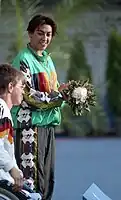
Australia represented by:
Men – Rodney Bonsack, Damien Bridger, Kingsley Bugarin, Brendan Burkett (swim captain), Jason Diederich, Bradley Evans, Paul Gockel, Simon Matthew Lee, Kieran Modra, Stephen Simmonds, David Smith, Phillip Tracey
Women – Kelly Barnes, Julie Barr, Tracy Barrell, Michelle Bate, Priya Cooper, Tracey Cross, Anne Currie, Catherine Huggett, Lyn Lillecrapp, Mandy Maywood, Tracey Oliver, Kirstyn Summerton, Danae Sweetapple, Sandra Yaxley, Judith Young
Coaches – Anne Green (Amputee), Phil Jose (Cerebral palsy), Kerry Smith (Cerebral palsy)
Officials – Ian McDowell-Jones (Vision impaired Manager), Rowenna Toppenberg (blind escort)[2][3]
Australian swimmers won 34 medals – 10 gold, 12 silver and 13 bronze medals. 7 athletes won gold medals.
Notable Performances – Priya Cooper was the most successful Australian athlete at the 1992 Paralympic games, earning herself three gold medals and two silver medals, only to go on to do even better in future games.[11] One of the gold medals Priya won was for her swim in the 200m medley, setting a new world record with a finishing time of 3 min 18.53sec.[12]
Members of the Australian Women's 4x50m Freestyle S1–6 team Sandra Yaxley, Tracy Barrell, Catherine Huggett, and Anne Currie won a gold medal smashing the world record in a time of 3min 26.50sec beating out Sweden and France.[4]
Victorian Anne Currie, shattered the world record in the 200m freestyle, taking nearly six seconds off the previously held record to finish in 3mins 11.14sec. This was Anne's third gold medal of the games.[12]
Gold Medals[13]
| Athlete | Event | Result | Rank |
|---|---|---|---|
| Sandra Yaxley, Tracy Barrell, Catherine Huggett, Anne Currie | Women's 4x50 m Freestyle S1-6 | 3:26.56 WR | |
| Tracey Cross | 400m Freestyle B1 | 5:52.89 | |
| Priya Cooper | 200m Individual Medley SM6-7 | 3:18.53 WR | |
| Anne Currie | 200m Freestyle S6 | 3:11.14 WR | |
| Priya Cooper | 100m Freestyle S8 | 1:17.70 PR | |
| Anne Currie | 100m Freestyle S6 | 1:31.39 WR | |
| Tracey Cross | 100m Freestyle B1 | 1:18.36 | |
| Mandy Maywood | 100m Breaststroke B3 | 1:26.73 | |
| Priya Cooper | 50m Freestyle S8 | 35.68 WR | |
| Tracy Barrell | 50m Butterfly S3-4 | 1:16.02 WR |
Results key
WR = World record
PR = Paralympic record

Table Tennis
Tabletennis is a competition open to wheelchair, amputee, cerebral palsy, intellectual disability and les autres athletes, and is split into both singles and doubles. The game is played to exactly the same rules as able-bodied competitions for standing players, and there is only slight variation to the rules for wheelchair table tennis.[6]
Australia represented by:
Men – Csaba Bobory[2][3]
Australia won no medals.
Wheelchair Basketball
Wheelchair basketball has been a part of the Paralympic Games since 1960, and sources indicate that it is one of the most popular wheelchair sports. The court, ring heigh and backboards are the same as the able-bodied game, with wheelchair basketball modelled after the able-bodied version. Players are classified with a points system that is based on their ability.[6]
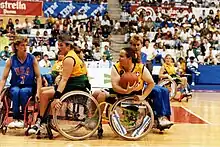
Australia represented by:
Men – Troy Andrews, Sandy Blythe, Michael Callahan, Stuart Ewin, David Gould, Gerry Hewson, Errol Hyde, Timothy Maloney, Richard Oliver, Troy Sachs, Stephen Trestrail, Michael Walker
Coach – Michael Tucker
Official – Graham Gould (escort)
Women – Amanda Carter, Coralie Churchett, Sue Hobbs, Paula Lohman, Lisa O'Nion, Donna Ritchie, Amanda Rose, Julie Russell, Sharon Slann, Liesl Tesch,
Coach – Peter Corr
Official – John Crossley (escort)[2][3]
Australia won no medals.
Wheelchair Fencing
Fencing in the Paralympics is only participated in by wheelchair athletes. The wheelchair is fixed to a wheelchair fencing frame during competition to improve safety and reduce likelihood of tipping, and to allow free upper body movement of the fencer.[6]
Australia represented by:
Men – Robert Jordan[2][3]
Australia won no medals.
Wheelchair Tennis
Wheelchair tennis having appeared as a demonstration sport at the 1988 Summer Paralympics and after its success at the games was admitted to the Paralympics at Barcelona 1992 where men's and women's singles and doubles were contested.[14]
Draft constitution and planning documents for the new federation were circulated to the nations after considerable planning and consultation with the International Tennis Federation (ITF). At their annual general meeting, the ITF adopts the two bounce rule in the official Rules of Tennis, officially sanctioning the new sport.[15]
Australia represented by:
Men – Mick Connell, David Hall
Women – Randa Hinson, Sue Twelftree[2][3]
Notable performance – Mick Connell advancing to the final where unfortunately was beaten by Laurent Giammartini of France.
| Athlete | Event | Round of 32 | Round of 16 | Quarterfinals | Semifinals | Final – Bronze Medal Match | Overall Rank |
|---|---|---|---|---|---|---|---|
| Opposition Result |
Opposition Result |
Opposition Result |
Opposition Result |
Opposition Result | |||
| Mick Connell | Men's Singles | W 6-1, 6-0 |
W 6-4, 6-0 |
W 7-6, 6-4 |
L 7-6, 4-6, 3-6 |
L 1-6, 0-4 |
4 |
Australia won no medals.
Funding
The funding for the Australian Paralympic team came from a number of stakeholders. Part funding of the Paralympic team was provided by Jim Fleming the founder of Franklins Supermarket. Jim agreed to support the team with the idea that athletes would visit local Franklin's supermarkets each Saturday morning to meet and greet members of the public. This allowed members of the community to get to know the athletes and follow their preparations leading up to the games. During the Paralympics, photographs of the athlete who visited a store were displayed that at the supermarket and press releases were sent to the supermarkets allowing members of the community to track athlete's progress and achievements during the games.[16]
The Australian Paralympic Federation received a $75,000 grant to help pay its way to the 1992 Paralympics in Barcelona.[17]
The remaining $100,000 to fund the Australian Paralympic Team was provided by Australian Sports Commission under the Federal Minister for Sport Ros Kelly in 1992.[16]
Radio played significant role for the 1992 Australian Paralympic team in the lead up to the games. Along with meet and greets, athletes participated in interviews talking about the upcoming Paralympics and media releases on ABC radio every Saturday morning. The ABC provided generous support to the athletes and did everything they could to make mention of the games during broadcasts. For example, they would promote the phone numbers needed for those wanting more information about the games. As a result of the coverage, listeners were phoning in and donating money in the lead up to the games. Donations were still being made during the games. Financial support was not the only benefit of the ABC's involvement, Australia importantly were understanding what a Paralympian was.[16]
Media Coverage
"It's a great leap forward for the whole Paralympic and disabled sporting movement in Australia,"
Kerry Cosgrove, Chairman of the Paralympic Federation[18]
The media attention at the 1992 Paralympic Games was quite strong, with requests from 1300 members of the press for accreditation and 42 television channels being represented in Barcelona for the games.[9] Whilst Australia did not have any live coverage of the games, highlight packages from the Games Broadcasting Authority were played every evening by the ABC during the 1992 Paralympics.[19]
The chairman of the Paralympic Federation, Kerry Cosgrove, said the prime-time coverage was a real boost for the athletes and would hopefully encourage further sponsorship. "It's a great leap forward for the whole Paralympic and disabled sporting movement in Australia", he said.[18]
The Madrid Games

The 1992 Paralympics was the first, and only year with a separate Paralympic Games with Persons with Mental Handicap. These games were held in Madrid and were sponsored by INAS-FMH, whilst still under ICC purview. The inclusion of athletes from the INAS-FMH was a complex issue, and after much back and forth between many organisations a request was made by the INAS-FMH. The president of the INAS-FMH, Mr Vicente, asked that the ICC sanction a games in a different location to Barcelona, but still under the Paralympic Flag. Voting in favour of this was unanimous and the games went ahead.[20]
Athletes qualified according to qualifying standards that were set in advance, and the games were open, meaning that no classification took place. The events also did not have any adaptation to suit athletes with any particular disability. More than 70 countries with around 2500 athletes and officials in total were involved. This total number involvement was more than expected at the time, so there was some strain placed on the organisational side of the games, however the sporting events were a success and sources indicate that "Many nations would have drawn meaningful motivation from their involvement in this world event"[9]
"The two gold medals joined a handsome collection from wins in the 100m freestyle, 200m freestyle, 100m butterfly, medley relay and 50m relay – four of which were achieved in world record times – and he still has two events to swim."
The Canberra Times, of Joseph Walker, a 21-year-old swimmer at the Madrid Games.[21]
Despite what has been said about the Madrid games being unifying and meaningful for many nations, other sources do indicate that the Madrid games are extremely rarely recognised as Paralympic Games, with even the IPC making no mention of the games, and no official results or medal lists available.[20] However, it does seem that Australia was unaware of this exclusion, with news reports at the time indicating that Australia, as a whole, believed that these games were a true part of the Paralympics, and those that were succeeding by winning medals, were Paralympic Champions. The Canberra Times published a news article boasting the success of the Australian Paralympians at the Madrid games,[21] showing that the Australian public was unaware of the coming controversy surrounding the lack of official recognition for these Athletes.
Australia came first in these games, finishing with a total of 32 medals: 13 gold, 10 silver and 8 bronze. The most notable performance for Australia was by the men's swimming team, and in particular, Joseph Walker, who won 9 medals in total, 5 individual and 4 relay.[20] This was undoubtedly a great success for Australia, with many Athletes excelling at these games, and bringing home a real win for Australia.
Political context
There was a great deal of controversy surrounding the 1992 Barcelona Paralympics, with much heated discussion taking place before the event. There had been considerations for a capitation fee to be charged to each of the athletes competing, however this was decided against and instead the INAS-FMH paid an overall capitation fee of US$10,000 to the ICC (International Coordinating Committee), which was very welcomed by the ICC treasurer. Furthermore, the medical treatment was offered for free for all athletes involved in the Summer Paralympics, and Michael Riding, the medical officer for the organising committee, was impressed. After visiting the medical facilities provided, he concluded that they were of a very high standard.[9] On top of this, the ICC had to discuss and decide on the re-entry of South Africa to the international sporting fraternity. Whilst other organisations such as the IOC and the International Stoke Mandeville Games Federation had already agreed to re-submit South Africa, however the ICC had not yet considered this. There was certainly enough president for the ICC to allow this resubmission, however the Paralympic Planning Committee wanted to know whether they would be required to provide places for the South African Paralympic Athletes. This would have to be considered and agreed to by the international federations.[9]
Drugs and Doping
Although doping offences were prevalent during the Barcelona Paralympics, no Australian athletes were involved.[9]
Homecoming
'Gold-medalled and starry eyed, I came home from Barcelona to the sort of public attention I had never dreamed of'
Louise Sauvage[22]
The athlete's were welcomed back with a ticker-tape parade down George St, Sydney, which was a wonderful boost for sports for athletes with a disability, helping to lift their profile. The attention and interest they created back home, were a turning point for our sports. After the games all gold medalists were awarded an Order of Australia Medal.[22]
See also
References
- ↑ "History". Australian Paralympic Committee Media Guide Beijing 2008. Australian Paralympic Committee. 2008. p. 16.
- 1 2 3 4 5 6 7 8 9 10 11 12 13 14 15 16 17 18 19 Australian Team Members Profile Handbook- Barcelona Paralympics 1992 (PDF). Sydney: Australian Paralympic Federation. 1992. Archived from the original (PDF) on 2012-08-09. Retrieved 15 February 2019.
- 1 2 3 4 5 6 7 8 9 10 11 12 13 14 15 16 17 "Australia at 1992 Barcelona". International Paralympic Committee Historical Results Database. Retrieved 23 June 2012.
- 1 2 "Sauvage takes a gold under 30sec". The Canberra Times. 11 September 1992. p. 26. Retrieved 20 October 2015 – via National Library of Australia.
- ↑ "Participation Numbers - Barcelona 1992 Paralympic Games". International Paralympic Committee Historical Results Database.
{{cite web}}: Missing or empty|url=(help) - 1 2 3 4 5 6 7 8 9 10 11 12 Epstein, Vicki (2002). Step by Step we Conquer: The Story of Queensland's Sporting Wheelies and Disabled Association. Southport: Keeaira Press. p. 127. ISBN 0958529191.
- 1 2 "Australian Results at 1988 Paralympics". International Paralympic Committee Historical Results Database. Retrieved 28 June 2012.
- ↑ "Eden takes silver in the discus". The Canberra Times. 5 September 1992. p. 13 Section: Saturday Magazine. Retrieved 19 October 2015 – via National Library of Australia.
- 1 2 3 4 5 6 Bailey, Steve (2007-12-27). Athlete First: A History of the Paralympic Movement. Online: John Wiley & Sons, Ltd. pp. 91–137. doi:10.1002/9780470724323. ISBN 9780470724323.
- ↑ "About the Sport". IPC Powerlifting. IPC Powerlifting. Retrieved 19 October 2015.
- ↑ Cashman, Richard; Darcy, Simon (2008-01-01). Benchmark Games. Benchmark Games. p. 40. ISBN 9781876718053.
- 1 2 "Australia's 'mermaid' shatters world record". The Canberra Times. 12 September 1992. p. 12 Section: Saturday Magazine. Retrieved 19 October 2015 – via National Library of Australia.
- ↑ IPC. "IPC Historical Results Database". Official website of the Paralympic Movement. IPC. Retrieved 27 October 2015.
- ↑ "Barcelona 1992". ITFTENNIS.com. International Tennis Federation. Retrieved 26 October 2015.
- ↑ "History". ITFTENNIS.com. International Tennis Federation. Retrieved 26 October 2015.
- 1 2 3 Smith, Adrienne & Willis, Rob, 1944- (Interviewer) & Naar, Tony. (Interviewer) (2011). Adrienne Smith interviewed by Rob Willis and Tony Naar in the Australian Centre for Paralympic Studies oral history project.
- ↑ "Paralympic grant". The Canberra Times. 30 May 1992. p. 31. Retrieved 19 October 2015 – via National Library of Australia.
- 1 2 "Games TV coverage for 21 hours a day". The Canberra Times. 9 July 1992. p. 20. Retrieved 19 October 2015 – via National Library of Australia.
- ↑ Cashman, Richard; Darcy, Simon (2008-01-01). Benchmark Games. Benchmark Games. p. 40. ISBN 9781876718053.
- 1 2 3 Brittain, Ian (2012-06-25). "Madrid 1992 – the Paralympic Games that time forgot!". paralympicanorak. Retrieved 28 October 2015.
- 1 2 AAP (21 September 1992). "Remarkable Walker takes a shine to Spitz". The Canberra Times. The Canberra Times. Retrieved 28 October 2015.
- 1 2 Sauvage, Louise (2002). Louise Sauvage: my story. Pymble, N.S.W.: HarperCollins. ISBN 9780732272630.